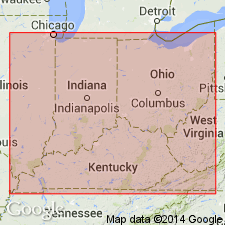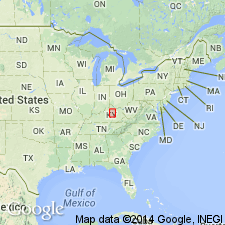
- Usage in publication:
-
- Faulconer limestone
- Modifications:
-
- Named
- Dominant lithology:
-
- Limestone
- AAPG geologic province:
-
- Cincinnati arch
Summary:
Named Faulconer limestone. Fossiliferous limestone that forms the lower part of Perryville member of Lexington limestone.
Source: GNU records (USGS DDS-6; Reston GNULEX).

- Usage in publication:
-
- Faulconer Bed*
- Modifications:
-
- Overview
- AAPG geologic province:
-
- Cincinnati arch
Summary:
"Faulconer Bed of Perryville Limestone Member of Lexington Limestone consists of brownish-gray fossiliferous calcilutite in rough-surfaced beds commonly about 0.5 foot thick. Some beds have a nodular internal structure that is inconspicuous in fresh exposures but becomes more obvious on weathering. Mollusks are the most conspicuous fossils, though brachiopods are present in some beds. Colonial corals, probably Tetradium, are common in the upper part. Stromatoporoids present. Pockets and lenses of small fossil debris are common and probably resulted from burrowing. Thin black shale partings separate some beds. Interbeds of fine-grained calcarenite are present in the unit." Thickness ranges from 0 to 40 ft. Underlain by and intertongues with Tanglewood Limestone Member of Lexington Limestone; overlain by Salvisa Bed of Perryville Limestone Member where present.
Source: GNU records (USGS DDS-6; Reston GNULEX).
For more information, please contact Nancy Stamm, Geologic Names Committee Secretary.
Asterisk (*) indicates published by U.S. Geological Survey authors.
"No current usage" (†) implies that a name has been abandoned or has fallen into disuse. Former usage and, if known, replacement name given in parentheses ( ).
Slash (/) indicates name conflicts with nomenclatural guidelines (CSN, 1933; ACSN, 1961, 1970; NACSN, 1983, 2005, 2021). May be explained within brackets ([ ]).

